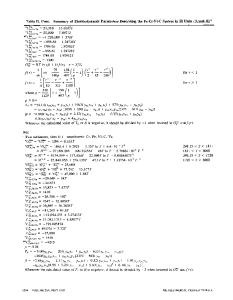Thermodynamic assessment of the Fe-Nb-Ti-C-N system
- PDF / 312,749 Bytes
- 17 Pages / 612 x 792 pts (letter) Page_size
- 55 Downloads / 599 Views
I. INTRODUCTION
AS hard materials and as precipitates in steels, the niobium and titanium carbonitrides, (Nb, Ti)(C, N), have a wide technical applicability. In order to maximize the beneficial effect of the niobium-titanium carbonitrides, it is important to predict their thermodynamic properties, i.e., their stability and composition changes at various temperature and overall composition and/or carbon/nitrogen potentials. The CALPHAD method,[1] where thermodynamic properties of individual phases in an alloy system are critically assessed and phase equilibria are calculated based on a Gibbs-energy-minimization criterion, can be a good tool to predict thermodynamic stability of the niobium-titanium carbonitrides. Great efforts have been made to describe the thermodynamic properties of the (Nb, Ti)(C, N) phase. For example, for the Ti-C binary system, four different thermodynamic descriptions[2–5] have been published during the last 5 years even though a thermodynamic description for that system was already available.[6] Even quaternary description of the Fe-Ti-C-N system had to be published twice[7,8] during the last 2 years by the same group. In the CALPHAD approach, a thermodynamic description of a higher-order system is based on thermodynamic descriptions of lower-order subsystems. For example, in order to construct a thermodynamic description of an A-B-C ternary system, the thermodynamic descriptions for the A-B, A-C, and B-C binary systems have to be prepared first. Due to the scattering in experimental information for thermodynamic properties of a binary system, there can be many thermodynamic parameter sets that can describe the thermodynamic properties of the binary system equally well within the uncertainty limit of experimental information. However, many thermodynamic parameter sets for a binary system often fail in describing ternary properties when combined with parameter sets for other binary systems. Even parameter sets for ternary systems can fail in describing higher-order
systems when combined with parameter sets for other ternary systems. Concerning the present niobium-titanium carbonitride system, good agreements between calculation and experimental information in the Ti-C, Ti-N, Nb-C, and Nb-N binary systems are not enough to guarantee successful applications of the binary thermodynamic parameter sets to the Fe-NbTi-C-N steel system or to the Nb-Ti-C-N ceramic system. As well as the individual stability of TiC, TiN, NbC, and NbN carbides or nitrides, the thermodynamic parameter sets should give good descriptions for solubility limits of each carbide or nitride in Fe and also for the relative stability among them. The reason for the frequent reassessments of the previously mentioned Ti-C binary and Fe-Ti-C-N quaternary systems should be understood as an effort to construct a self-consistent thermodynamic database that can describe the higher-order system as well as the binary system. Even though the (Nb, Ti)(C, N) carbonitrides are of practical importance, a thermodynamic parameter set of the Fe
Data Loading...











